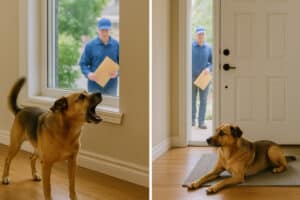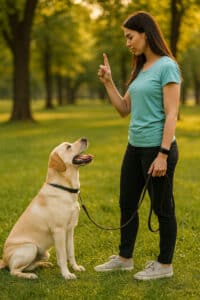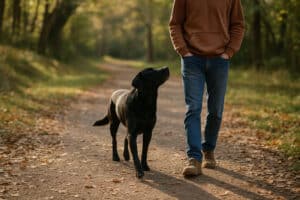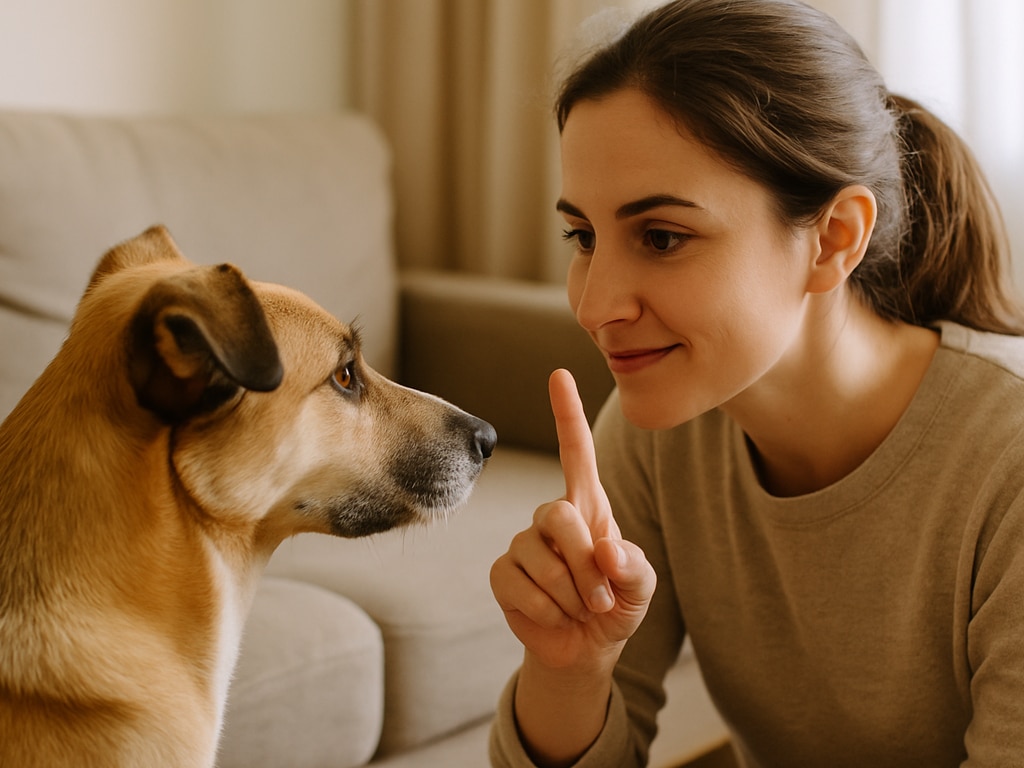Breaking Old Habits: Transforming Behaviour Through Consistent Dog Training
Changing behaviour isn’t about fixing a broken dog. It’s about teaching better choices. And if you’ve ever felt like your dog “just doesn’t get it,” you’re not alone. Most behaviour issues aren’t about defiance or dominance. They’re habits. Rehearsed patterns. Loops your dog has been stuck in because nobody’s shown them how to do something different. That’s exactly what we fix every day in our in-home private dog training in Hamilton sessions at K9 Principles. We don’t just deal with the surface behaviour – we look at the cause. We dig into what’s really being reinforced. And we create a whole new roadmap for your dog to follow, one cue at a time.
So if you’re tired of the barking, the pulling, the jumping, or the ignoring, this article is for you. Not only will you learn how habits form and why they stick, but more importantly, you’ll learn how to break them – with science, strategy, and a whole lot of consistency.
The Hidden Power of Habit in Dogs
Let’s start with the big picture. Dogs are creatures of habit. They don’t wake up thinking, “Today I’ll misbehave.” They just do what has worked in the past. That’s how their brains are wired. Every time your dog does something and it gets them a reward – even an unintentional one – they store that sequence. Cue leads to behaviour leads to consequence. That loop, repeated enough times, becomes automatic.
A dog that jumps on guests doesn’t do it because they’re bold. They do it because it got them attention once… and then again… and again. A dog that barks out the window isn’t trying to protect you – they’ve just learned that barking makes the mail carrier go away. It’s not logic. It’s pattern.
The truth is, most behaviour issues aren’t problems with obedience – they’re problems with pattern. And unless we interrupt that loop, the behaviour will just keep rehearsing itself into muscle memory.
Why Repetition Builds Behaviour (Even the Bad Ones)
Repetition is powerful. Think of your own habits. You probably brush your teeth in the same rhythm every day, or instinctively reach for your phone without thinking. Your brain isn’t deciding – it’s following a path it knows well. Dogs are the same. Repetition builds reliability.
Unfortunately, the brain doesn’t discriminate between helpful and unhelpful habits. If a behaviour works – even once – it gets stored. And if it keeps working? It becomes second nature. That’s why, at K9 Principles, we never try to “correct” a habit into submission. We replace it. Because once a dog has rehearsed something long enough, you’re not going to argue it out of them – you have to retrain the entire sequence from the beginning.
That’s where consistency, timing, and clarity come in. It’s not about being strict. It’s about being strategic.
How Dogs Interpret Your Behaviour (Even When You’re Not Training)
One of the most important things we teach in our Hamilton dog training programs is that training never stops. Every interaction – every glance, every step, every reaction – teaches your dog something. And they’re watching closely.
If your dog jumps and you laugh, even just once, that behaviour just got rewarded. If you tell them to stay and then call them back while still walking, you’ve broken your own cue. If you’re inconsistent with your expectations – letting them on the couch sometimes but not others – you’re building confusion, not clarity.
Dogs learn through consequence, not conversation. They don’t understand, “Only do that when guests aren’t here” or “Don’t jump unless I’m wearing old clothes.” They understand cause and effect. That’s why the results you get are always a reflection of what’s being reinforced – not just during training sessions, but in real life, all the time.
Identifying the Cues That Trigger Old Habits
Every habit has a cue. It could be a word, a motion, a sound, or even a certain time of day. The doorbell rings, and your dog rushes to the door. You pick up the lead, and they start whining. You open the fridge, and they appear like a magician.
When we work with clients at K9 Principles, one of our first goals is to identify those cues. What’s triggering the behaviour you want to change? Is it environmental? Is it emotional? Is it situational?
Once we know the cue, we can change the pattern. Not by removing the cue – that’s not always possible – but by rewriting the behaviour that follows it. Instead of barking at the doorbell, your dog learns to go to their bed. Instead of pulling when they see a squirrel, they learn to look at you for direction. The cue stays. The response changes. That’s true behaviour change.

Why Saying “No” Isn’t a Training Plan
This is one of the hardest truths for new dog owners to accept. Telling your dog “no” doesn’t teach them what to do. It only tells them what not to do. And when they’re left in the dark about the right choice, they’ll keep guessing – or keep doing what’s always worked.
Imagine you’re trying to learn a new dance, and your instructor only says “wrong” without showing you the right move. Frustrating, right? That’s how your dog feels when you constantly interrupt, correct, or scold without offering a clear alternative.
At K9 Principles, our focus is always on teaching an incompatible behaviour. If the problem is jumping, we teach a sit. If the problem is barking, we teach quiet focus. If the problem is pulling, we teach a calm wait or check-in. It’s not enough to stop the old habit. You have to replace it with something better – and then reward it like crazy.
The Importance of Teaching Replacement Behaviours
Let’s say your dog jumps up when people come in. You don’t want that. But you can’t just expect them to do nothing. They need an outlet. So we teach them to go to a mat. That mat becomes their job. Guests arrive, and your dog knows exactly what to do. That’s powerful.
The same principle applies to so many habits. Barking? Replace it with quiet attention. Chewing furniture? Replace it with a structured chew routine. Lunging on lead? Replace it with structured heel work and reward-based redirection.
You’re not eliminating behaviour. You’re redirecting it. And when done consistently, that new behaviour becomes the habit. It’s not magic. It’s just the brain choosing the path of least resistance – and that path is the one that’s been reinforced most often.

What Consistency Actually Means in Real Life
Consistency isn’t about being perfect. It’s about being predictable. If your dog knows what to expect from you, they’ll start making better choices on their own. But if you send mixed messages – sometimes enforcing rules, other times letting things slide – they’ll test, push, and get stuck in the very habits you’re trying to break.
With our dog training in Hamilton, we often ask clients to commit to two weeks of extreme clarity. That means no grey areas. Couch rules are always the same. Door manners are reinforced every single time. Rewards are consistent. Corrections (if used) are calm, clear, and fair.
What happens next is incredible. Your dog relaxes. They stop guessing. The bad habits lose power because they no longer lead anywhere. And the new habits take hold because they’re rewarded every single time. That’s what consistency looks like – not perfection, but unwavering clarity.
The Reality of Regression and Frustration
Let’s be honest. Habit change isn’t linear. Even with perfect training, your dog might backslide. That doesn’t mean the training failed – it means your dog is testing. This is completely normal. It’s called an extinction burst – a temporary spike in the old behaviour as your dog tries to make it work again.
Think of it like a vending machine. You press the button, and nothing happens. What do you do? You press it again. Maybe harder. Maybe a few more times. That’s the extinction burst. But eventually, you walk away. Why? Because it doesn’t work anymore.
Your dog will do the same. The behaviour will spike. They’ll test. They’ll push. But if you don’t give in – if you stay consistent and stick to the new rules – that behaviour fades. It’s replaced. And that’s when the real transformation happens.
Using Management Tools to Prevent Rehearsal
While you’re retraining, management is your best friend. You can’t expect your dog to unlearn something if they’re still rehearsing it. If your dog jumps at guests, use a gate or leash until the new behaviour is solid. If they chew furniture, manage access until you’ve built a better routine. Management isn’t forever – it’s a temporary strategy to set your dog up for success.
At K9 Principles, we’ll show you exactly when and how to use tools like long leads, crates, baby gates, and more to prevent failure and create more opportunities for reinforcement. Because every time your dog rehearses the old habit, it gets stronger. Our job is to stop that rehearsal and replace it with learning.
Emotional Triggers and Behavioural Layers
Some habits aren’t just annoying – they’re rooted in emotion. Fear. Frustration. Anxiety. In these cases, the behaviour isn’t the real issue – it’s a symptom. That’s why we don’t treat barking or reactivity at face value. We look underneath.
If your dog barks at strangers, is it because they’re excited? Or are they fearful? If they chew when you leave, is it boredom? Or separation anxiety? The answer changes the training plan entirely. That’s the value of experience. At K9 Principles, we know how to read the emotional layers behind the habit and create a plan that addresses both the behaviour and the reason behind it.
What to Expect When Working With Us

We’re not a one-and-done, “fix your dog in 60 minutes” company. We’re a relationship-based training team that works with real families in real homes. When you sign up for our in-home private Hamilton dog training sessions, here’s what you can expect:
We start with a full behavioural intake to understand your dog’s history, triggers, and reinforcement history. We then create a custom training plan built around your goals and lifestyle. We coach you through every step – not just the “how” but the “why.” And we support you through setbacks, regression, and breakthroughs. Because breaking habits isn’t a one-week job. But it is absolutely possible when you have the right roadmap – and a trainer who understands what’s really going on beneath the surface.
The Mindset Shift That Changes Everything
If you take one thing from this article, let it be this: your dog isn’t doing this to spite you. They’re not stubborn. They’re not broken. They’re just stuck in a loop that’s been reinforced over time. And you have the power to change that loop. You don’t need to be stricter. You need to be clearer. You don’t need to dominate. You need to lead.
Every behaviour tells a story. At K9 Principles, we’re here to help you read it, understand it, and rewrite it in a way that builds connection, not conflict. The moment you start training with clarity, consistency, and compassion, the transformation begins. And once those new habits take root, the old ones have no reason to return.
That’s real dog training. And it starts right here.
Contact us for more information:
- Name: K9 Principles
- Address: Haldimand County, Greater Hamilton Area, Burlington, and Most of Norfolk County
- Phone: 289 880-3382
- Email: k9principlesinc@gmail.com
- Website: www.k9principles.ca
FAQs
-
A1. Yes – absolutely. The key is consistency, clarity, and reinforcement. We’ve helped many dogs overcome long-standing habits simply by changing the patterns and rewards that shaped them.






